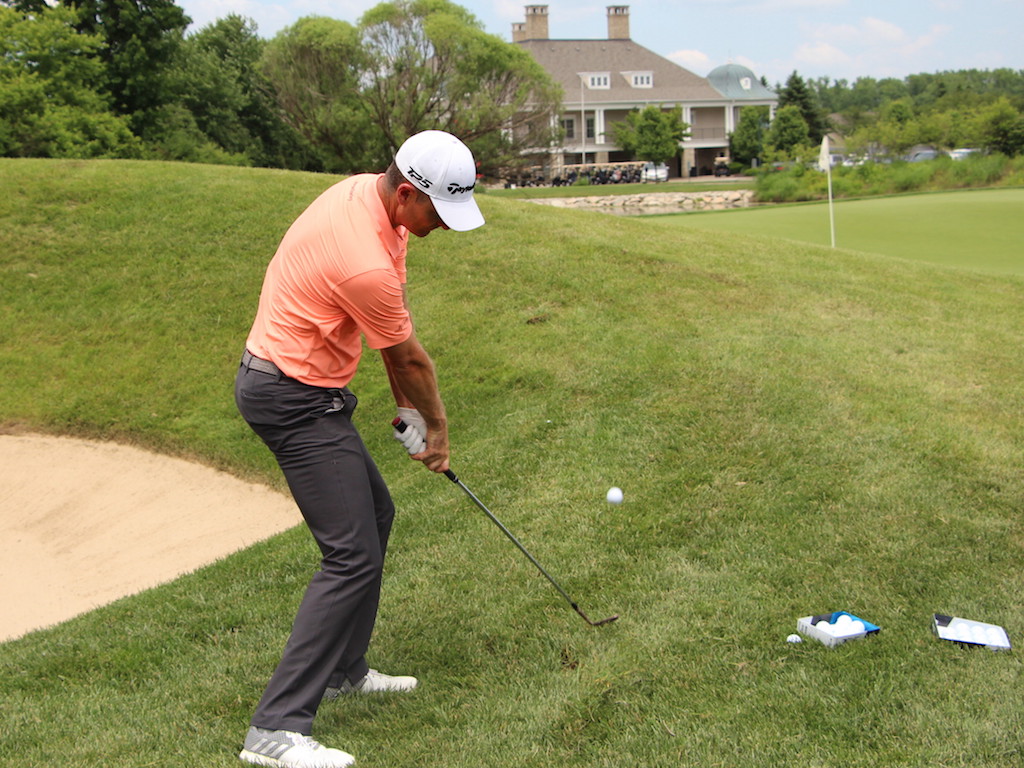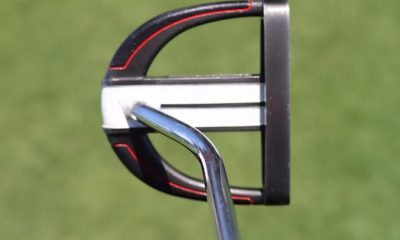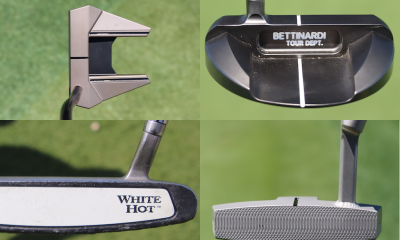Instruction
The Wedge Guy: Short game tempo

One of my favorite things to do is observe golfers closely, watching how they go about things from well before the shot to the execution of the swing or stroke. Guess the golf course has become kind of like going to the lab, in a way.
One thing I notice much too often is how “quick” most golfers are around the greens. It starts with grabbing a club or two from the cart and quickly getting to their ball. Then a few short jabs at a practice swing and usually a less-than-stellar result at a recovery.
Why?
If you are going to spend a morning or afternoon on the course, why hurry around the greens? I tend to be a fast player and despise five-hour rounds, but don’t fault anyone for taking a few seconds extra to get “right” with their recovery shot. You can still play “ready golf” and not short yourself in the close attention to execution. But let me get back to the specific topic.
Maybe it’s aggravated by this rush, but most golfers I observe have a short game tempo that is too quick. Chips, pitches and recoveries are precision swings at less than full power, so they require a tempo that is slower than you might think to accommodate that precision. They are outside the “norm” of a golf swing, so give yourself several practice swings to get a feel for the tempo and power that needs to be applied to the shot at hand.
I also think this quick tempo is a result of the old adage “accelerate through the ball.” We’ve all had that pounded into our brains since we started playing, but my contention is that it is darn hard not to accelerate . . . it’s a natural order of the swing. But to mentally focus on that idea tends to produce a short, choppy swing, with no rhythm or precision. So, here’s a practice drill for you.
- Go to your practice range, the local ball field, schoolyard or anywhere you can safely hit golf balls 20-30 yards or less.
- Pick a target only 30-50 feet away and hit your normal pitch, observing the trajectory.
- Then try to hit each successive ball no further, but using a longer, more flowing, fluid swing motion than the one before. That means you’ll make the downswing slower and slower each time, as you are moving the club further and further back each time.
My bet is that somewhere in there you will find a swing length and tempo where that short pitch shot becomes much easier to hit, with better loft and spin, than your normal method.
The key to this is to move the club with the back and through rotation of your body core, not just your arms and hands. This allows you to control tempo and applied power with the big muscles, for more consistency.
Try this and share with all of us if it doesn’t open your eyes to a different way of short game success.
- LIKE219
- LEGIT33
- WOW7
- LOL7
- IDHT4
- FLOP3
- OB1
- SHANK5
Instruction
Clement: Laid-off or perfect fade? Across-the-line or perfect draw?

Some call the image on the left laid off, but if you are hitting a fade, this could be a perfect backswing for it! Same for across the line for a draw! Stop racking your brain with perceived mistakes and simply match backswing to shot shape!
- LIKE0
- LEGIT0
- WOW0
- LOL0
- IDHT0
- FLOP0
- OB0
- SHANK1
Instruction
The Wedge Guy: The easiest-to-learn golf basic

My golf learning began with this simple fact – if you don’t have a fundamentally sound hold on the golf club, it is practically impossible for your body to execute a fundamentally sound golf swing. I’m still a big believer that the golf swing is much easier to execute if you begin with the proper hold on the club.
As you might imagine, I come into contact with hundreds of golfers of all skill levels. And it is very rare to see a good player with a bad hold on the golf club. There are some exceptions, for sure, but they are very few and very far between, and they typically have beat so many balls with their poor grip that they’ve found a way to work around it.
The reality of biophysics is that the body moves only in certain ways – and the particulars of the way you hold the golf club can totally prevent a sound swing motion that allows the club to release properly through the impact zone. The wonderful thing is that anyone can learn how to put a fundamentally sound hold on the golf club, and you can practice it anywhere your hands are not otherwise engaged, like watching TV or just sitting and relaxing.
Whether you prefer an overlap, interlock or full-finger (not baseball!) grip on the club, the same fundamentals apply. Here are the major grip faults I see most often, in the order of the frequency:
Mis-aligned hands
By this I mean that the palms of the two hands are not parallel to each other. Too many golfers have a weak left hand and strong right, or vice versa. The easiest way to learn how to hold the club with your palms aligned properly is to grip a plain wooden ruler or yardstick. It forces the hands to align properly and shows you how that feels. If you grip and re-grip a yardstick several times, then grip a club, you’ll see that the learning curve is almost immediate.
The position of the grip in the upper/left hand
I also observe many golfers who have the butt of the grip too far into the heel pad of the upper hand (the left hand for right-handed players). It’s amazing how much easier it is to release the club through the ball if even 1/4-1/2″ of the butt is beyond the left heel pad. Try this yourself to see what I mean. Swing the club freely with just your left hand and notice the difference in its release from when you hold it at the end of the grip, versus gripping down even a half inch.
To help you really understand how this works, go to the range and hit shots with your five-iron gripped down a full inch to make the club the same length as your seven-iron. You will probably see an amazing shot shape difference, and likely not see as much distance loss as you would expect.
Too much lower (right) hand on the club
It seems like almost all golfers of 8-10 handicap or higher have the club too far into the palm of the lower hand, because that feels “good” if you are trying to control the path of the clubhead to the ball. But the golf swing is not an effort to hit at the ball – it is a swing of the club. The proper hold on the club has the grip underneath the pad at the base of the fingers. This will likely feel “weak” to you — like you cannot control the club like that. EXACTLY. You should not be trying to control the club with your lower/master hand.
Gripping too tightly
Nearly all golfers hold the club too tightly, which tenses up the forearms and prevents a proper release of the club through impact. In order for the club to move back and through properly, you must feel that the club is controlled by the last three fingers of the upper hand, and the middle two fingers of the lower hand. If you engage your thumbs and forefingers in “holding” the club, the result will almost always be a grip that is too tight. Try this for yourself. Hold the club in your upper hand only, and squeeze firmly with just the last three fingers, with the forefinger and thumb off the club entirely. You have good control, but your forearms are not tense. Then begin to squeeze down with your thumb and forefinger and observe the tensing of the entire forearm. This is the way we are made, so the key to preventing tenseness in the arms is to hold the club very lightly with the “pinchers” — the thumbs and forefingers.
So, those are what I believe are the four fundamentals of a good grip. Anyone can learn them in their home or office very quickly. There is no easier way to improve your ball striking consistency and add distance than giving more attention to the way you hold the golf club.
More from the Wedge Guy
- The Wedge Guy: Golf mastery begins with your wedge game
- The Wedge Guy: Why golf is 20 times harder than brain surgery
- The Wedge Guy: Musings on the golf ball rollback
- LIKE87
- LEGIT13
- WOW6
- LOL1
- IDHT0
- FLOP4
- OB1
- SHANK8
Instruction
Clement: Stop ripping off your swing with this drill!

Not the dreaded headcover under the armpit drill! As if your body is defective and can’t function by itself! Have you seen how incredible the human machine is with all the incredible feats of agility all kinds of athletes are accomplishing? You think your body is so defective (the good Lord is laughing his head off at you) that it needs a headcover tucked under the armpit so you can swing like T-Rex?
- LIKE0
- LEGIT2
- WOW2
- LOL0
- IDHT0
- FLOP0
- OB0
- SHANK2
-

 19th Hole2 weeks ago
19th Hole2 weeks agoDave Portnoy places monstrous outright bet for the 2024 Masters
-

 19th Hole4 days ago
19th Hole4 days agoJustin Thomas on the equipment choice of Scottie Scheffler that he thinks is ‘weird’
-

 19th Hole2 weeks ago
19th Hole2 weeks agoTiger Woods arrives at 2024 Masters equipped with a putter that may surprise you
-

 19th Hole4 days ago
19th Hole4 days ago‘Absolutely crazy’ – Major champ lays into Patrick Cantlay over his decision on final hole of RBC Heritage
-

 19th Hole2 weeks ago
19th Hole2 weeks agoTwo star names reportedly blanked Jon Rahm all week at the Masters
-

 19th Hole1 week ago
19th Hole1 week agoReport: LIV Golf identifies latest star name they hope to sign to breakaway tour
-

 19th Hole2 weeks ago
19th Hole2 weeks agoNeal Shipley presser ends in awkward fashion after reporter claims Tiger handed him note on 8th fairway
-

 19th Hole1 week ago
19th Hole1 week agoBrandel Chamblee has ‘no doubt’ who started the McIlroy/LIV rumor and why
























Pingback: Short game tempo drill - SOCAL Golfer
Olle Eriksson
Jul 23, 2022 at 6:15 pm
My guess is that the quick tempo comes from the full swing where things are more forceful. So when you’re suddenly facing a chip shot or a pitch shot it’s hard to slow down just let gravity do the work.
DKey
Jun 3, 2022 at 10:08 am
Agree completely. This is what Lee Trevino preaches. And this is why – when Tiger, Charlie and Lee were together on the practice range at the PNC – Tiger told Charlie that Lee Trevino is ‘…why you draw your wedges…” great insight, thank you The Wedge Guy
ChipNRun
May 15, 2022 at 1:43 pm
Terry said:
“Then try to hit each successive ball no further, but using
a longer, more flowing, fluid swing motion than the one
before. That means you’ll make the downswing slower and
slower each time, as you are moving the club further and
further back each time.”
This may work for feelers, but for mechanics who use the Pelz clockface method this is a no-go. Us wedge matrix golfers vary the length of backswing + selected club, to walk the wedge shots forward and back inside 100 yards.
The fluid swing motion is a great way to decelerate your swing and leave the ball 30 feet short of the pin. You worry about over acceleration, but forget the dangers of deceleration.
Plus, if depends on where one plays. If the course just fertilizes fairways and greens, this may work. But, if you play a course that fertilizes the turf wall-to-wall, the off-green grass can be pretty dense.
Spindly rough a la British links may allow a “gravity drop” short game. But well nourished zoysia or bent will grab the wedge like a wet blanket. Again, the ball will end up 30 feet short of the pin.
Jim Champley
May 13, 2022 at 5:52 pm
It’s “farther,” not “further !”
Bob Jones
May 13, 2022 at 10:45 am
Amen. These are finesse shots. These are delicate shots. Light grip pressure and a respectful tempo work wonders.
Rainshadow
May 11, 2022 at 11:09 am
In the “rush” to combat slow play, I think people get it backwards.
Be ready to hit full shots when it’s your turn. Take your time around and on the greens.
I see too many people not ready to play on the tee or from the fairway, then feel pressured to play quickly at the green.